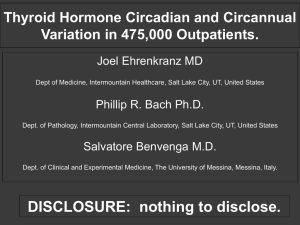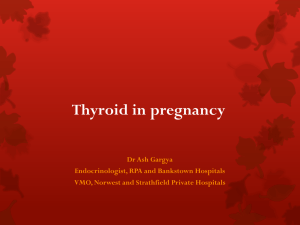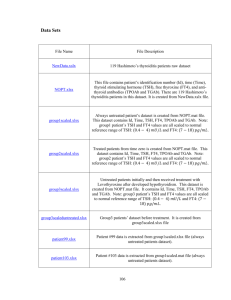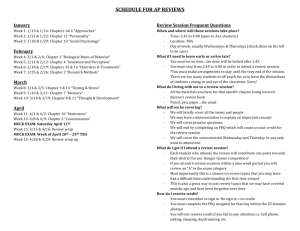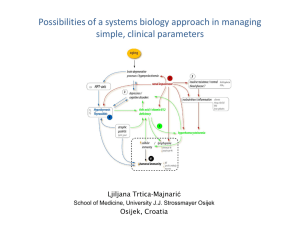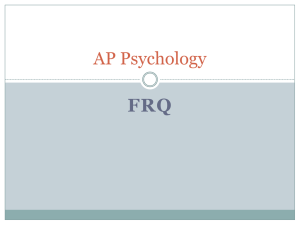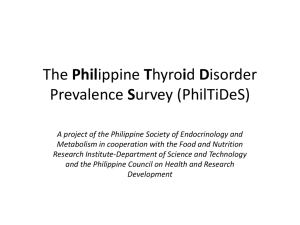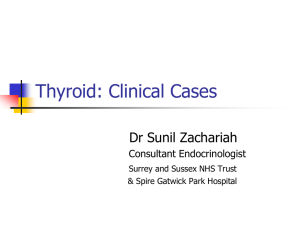abstract
advertisement
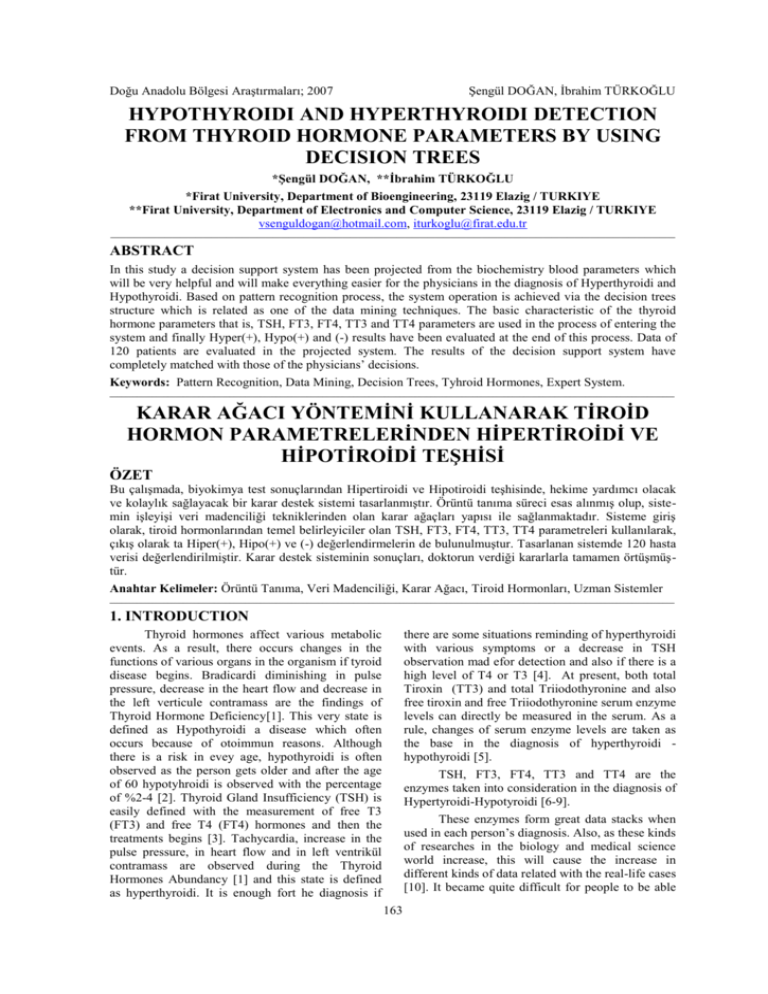
Doğu Anadolu Bölgesi Araştırmaları; 2007 Şengül DOĞAN, İbrahim TÜRKOĞLU HYPOTHYROIDI AND HYPERTHYROIDI DETECTION FROM THYROID HORMONE PARAMETERS BY USING DECISION TREES *Şengül DOĞAN, **İbrahim TÜRKOĞLU *Firat University, Department of Bioengineering, 23119 Elazig / TURKIYE **Firat University, Department of Electronics and Computer Science, 23119 Elazig / TURKIYE vsenguldogan@hotmail.com, iturkoglu@firat.edu.tr __________________________________________________________________________________________________________________________________________________ ABSTRACT In this study a decision support system has been projected from the biochemistry blood parameters which will be very helpful and will make everything easier for the physicians in the diagnosis of Hyperthyroidi and Hypothyroidi. Based on pattern recognition process, the system operation is achieved via the decision trees structure which is related as one of the data mining techniques. The basic characteristic of the thyroid hormone parameters that is, TSH, FT3, FT4, TT3 and TT4 parameters are used in the process of entering the system and finally Hyper(+), Hypo(+) and (-) results have been evaluated at the end of this process. Data of 120 patients are evaluated in the projected system. The results of the decision support system have completely matched with those of the physicians’ decisions. Keywords: Pattern Recognition, Data Mining, Decision Trees, Tyhroid Hormones, Expert System. __________________________________________________________________________________________________________________________________________________ KARAR AĞACI YÖNTEMİNİ KULLANARAK TİROİD HORMON PARAMETRELERİNDEN HİPERTİROİDİ VE HİPOTİROİDİ TEŞHİSİ ÖZET Bu çalışmada, biyokimya test sonuçlarından Hipertiroidi ve Hipotiroidi teşhisinde, hekime yardımcı olacak ve kolaylık sağlayacak bir karar destek sistemi tasarlanmıştır. Örüntü tanıma süreci esas alınmış olup, sistemin işleyişi veri madenciliği tekniklerinden olan karar ağaçları yapısı ile sağlanmaktadır. Sisteme giriş olarak, tiroid hormonlarından temel belirleyiciler olan TSH, FT3, FT4, TT3, TT4 parametreleri kullanılarak, çıkış olarak ta Hiper(+), Hipo(+) ve (-) değerlendirmelerin de bulunulmuştur. Tasarlanan sistemde 120 hasta verisi değerlendirilmiştir. Karar destek sisteminin sonuçları, doktorun verdiği kararlarla tamamen örtüşmüştür. Anahtar Kelimeler: Örüntü Tanıma, Veri Madenciliği, Karar Ağacı, Tiroid Hormonları, Uzman Sistemler __________________________________________________________________________________________________________________________________________________ 1. INTRODUCTION Thyroid hormones affect various metabolic events. As a result, there occurs changes in the functions of various organs in the organism if tyroid disease begins. Bradicardi diminishing in pulse pressure, decrease in the heart flow and decrease in the left verticule contramass are the findings of Thyroid Hormone Deficiency[1]. This very state is defined as Hypothyroidi a disease which often occurs because of otoimmun reasons. Although there is a risk in evey age, hypothyroidi is often observed as the person gets older and after the age of 60 hypotyhroidi is observed with the percentage of %2-4 [2]. Thyroid Gland Insufficiency (TSH) is easily defined with the measurement of free T3 (FT3) and free T4 (FT4) hormones and then the treatments begins [3]. Tachycardia, increase in the pulse pressure, in heart flow and in left ventrikül contramass are observed during the Thyroid Hormones Abundancy [1] and this state is defined as hyperthyroidi. It is enough fort he diagnosis if there are some situations reminding of hyperthyroidi with various symptoms or a decrease in TSH observation mad efor detection and also if there is a high level of T4 or T3 [4]. At present, both total Tiroxin (TT3) and total Triiodothyronine and also free tiroxin and free Triiodothyronine serum enzyme levels can directly be measured in the serum. As a rule, changes of serum enzyme levels are taken as the base in the diagnosis of hyperthyroidi hypothyroidi [5]. TSH, FT3, FT4, TT3 and TT4 are the enzymes taken into consideration in the diagnosis of Hypertyroidi-Hypotyroidi [6-9]. These enzymes form great data stacks when used in each person’s diagnosis. Also, as these kinds of researches in the biology and medical science world increase, this will cause the increase in different kinds of data related with the real-life cases [10]. It became quite difficult for people to be able 163 Doğu Anadolu Bölgesi Araştırmaları; 2007 Şengül DOĞAN, İbrahim TÜRKOĞLU to comprehend and change hundreds of characteristics and thousands of images into meaningful knowledge in modern medical science [11, 12] DNA [13, 14] and protein synthesis [15], biological state measurements [16], graphs [17] and enzymes [10] are some of the main types of data which are still being used. As the data increased it became quite a boring and difficult work for the medical science experts to prepare a guide that will be used in the processes of reading, simplifying, classifying the findings and making a decision at the end. Also a lot of findings hidden in these data have remained as the data stack in this way. It is necessary to get these data automized in order to obtain useful information. Getting information from the databases or the data mining is the kind of method mostly used for solving these kinds of problems [18]. Data mining is used for both getting the information related with the text and the information of the image data of an individual patient and then for matching each patient’s entry [19]. In this context data mining has been applied so successsfully in many fields of medical science [1820]. For instance, there are a lot of work that can be seen in the literature related with discovering certain rules in the diagnosis and treatment of acute ailments; applying the determined rules and making complementary data mining for defining the enlargement states of the working procedures of the refined, shared, organized and produced information in the system [21] and also there are some works related with projecting a Data Acquiring System for the baby deaths due to the Hypoplastic Left Heart Syndrome and making quick and true guesses using the acquired data [22]. Data warehouses in medicine field are called clinical warehouse too. Then, those clinical stores containing biological, clinical and administrating data unit the patients information. [23]. of patterns to features that are regarded as a condensed representation, ideally containing all the necessary information. In the next stage, the feature selection step, a smaller number of meaningful features that best represent the given pattern without redundancy are identified. Finally, classification is carried out: a specific pattern is assigned to a specific class according to its characteristic features selected for it. This general abstract model, which is demonstrated in Figure 1, allows a broad variety of different realizations and implementations. Applying this terminology to the medical diagnostic process, the patterns can be identified, for example, as particular, formalized symptoms, recorded signals, or a set of images of a patient. The classes obtained represent the variety of different possible diagnoses or diagnostic statements [24]. The techniques applied to pattern recognition use artificial intelligence approaches [25]. patterns feature extraction / selection classes classification Figure 1. Pattern Recognition System. 2.2. THYROID HORMONE PARAMETERS Thyroid-Stimulating Hormone (TSH):The thyroid is unique among the endocrine glands because it has a large store of hormone and a slow rate of normal turnover. Stimulation of the thyroid glan by the TSH, which is produced by the anterior pituitary gland, causes the release and distribution of stored thyroid hormones. TSH stimulates secretion of T 4 and T3. TSH secretion is physiologically regulated by T3 and T4 (feedback inhibition) and is stimulated by thyrotropin-releasing hormone (TRH) from the hypothalamus. Free Triiodothyronine (FT3): This is one of the determinations used to evaluate thyroid function and measure that fraction of the circulatory T 3 that exists in the free state in the blood, unbound to protein. FT3 is done to rule out T3 toxicosis, to evaluate thyroid replacement therapy, and to clarify proteinbinding abnormalities. Free Thyroxine T4 (FT4): Free thyroxine (FT4) comprises a small fraction of total thyroxine. The free FT4 is unbound to protein and available to the tissues, and it is the metabolically active form of this hormone. This fraction constitutes ~5% of the circulatory thyroxine T4 [26]. In this study, a decision support system which will be helpful for the diagnosis of hyperthyroidi and hypothyroidi is improved to be used for the aim of classifying the decision tree construction in the data mining techniques. Thyroid hormone parameters in biochemistry data were used for application and 120 patients’ data have been evaluated successfully. 2. THEORETICAL VIEW In this part, the information related with the easier conception of the decision support system’s construction in hyperthyroidi and hypothyroidi diagnosis is introduced in the shape of subclassifications. 2.3. DATA MINING Data mining is the work of achieving the information that enables us to find the relations among the great numbers of data which will be very helpful for making guesses about the future by using a computer programme. That is, the aimed information is obtained by processing the data. Data 2.1. PATTERN RECOGNITION Pattern recognition can be divided into a sequence of stages, starting with feature extraction from the occurring patterns, which is the conversion 164 Doğu Anadolu Bölgesi Araştırmaları; 2007 Şengül DOĞAN, İbrahim TÜRKOĞLU mining is used in many fields such as biomedicine, gene functions, data analysis of DNA arrangement pattern, diagnosis of illnesses, retail data, telecommunication industry, guesses about selling, financial analysis and astronomy [27]. For instance, due to the unsystematic data, the lack of control, the usage of too many various kinds, being unable to make a consistent and systematic analysis on databases, comparing the examples and determining the critical differences some of the standart softwares used in diagnosis system were defective. So, the physicians were in the opinion that these softwares were short of many characteristics. In this Original Database context, data mining which makes it possible to make a basic analysis on the graphs related with both the digital parameters and morphemes by the help of an expert information system and which stores the processes, administers the necessary information and also which includes a very useful construction such as a reference for decision, took an active position. [28]. In fact data mining is evaluated as a part of the information discovery process both in medical science and in the other fields [29]. Data mining stages are presented in Figure 2 [30]. Selected Database Discovered Patterns Obtained Results Figure 2. Data Mining Processes. Data mining has an interaction with the user and the database. Interesting data patterns are showed to the user. And also, they can be saved in the database if wanted [31]. Firstly the necessary data are taken, classified and then processed while obtaining meaningful information from the databases [12]. Classification in data mining is used for an automatic definition of the interesting object in great data and for the information discovery in the applications including the classification of the trend in the market [32]. There are a lot of methods used for classifying these data. In data mining the decision trees among these techniques, which have the characteristics of making guesses and defining, have the most common usage in the classification models because of the following reasons: [33] by the help of the medical observation [25,35]. Rule Extraction Structure is given in table 1 [36]. Table 1. Rule Extraction. If (Rule1) then (Decision1) Else if (Rule2) then (Decision2). Rule= <a1> and … and <an> Decision= Ψ, ΨЄ[ Ω1….Ωm ] Here each one of decision class’ parts that will be taken in rules is represented with Ω and the result that will be got from that class parts is represented with Ψ. The preparation of such a decision list constitutes an important step in a medical application and a decision tree can be created easily according to these rules[18]. A decision tree algoritm that is created according to these rules constitutes a decision tree in the context of information obtainment [37]. Inexpensiveness of the organization, Easiness in interpretation, Their possibility of being easily integrated with the database systems, More reliability. Rule 1 2.4. DECISION TREES After the data are created in decision trees, the rules can be written down on the tree from root to the leaf (If-Then rules). Getting decision in this way provides the confirmation of the result of the work of data mining. These rules can be checked in terms of application by showing them to an expert whether they are meaningful or not [34]. The decision trees are used in the analysis and applications of classifying various cases into lowmid or high risk groups; creating rules in order to predict the future events; definition of the relations of the certain sub-groups; the unition of the categories and getting the most effective decisions No Yes Decision 1 Rule 2 Yes Decision 2 No Rule N Figure 3. Decision Tree Structure. 165 Doğu Anadolu Bölgesi Araştırmaları; 2007 Şengül DOĞAN, İbrahim TÜRKOĞLU database. The data collected are being processed in this stage. For this, the rules underlined in table 2 and determined according to the physician’s knowledge and then the decision tree in figure 5 was obtained in relation with this knowledge. 3. DEVELOPED METHOD The most common and main tests that help the physicians decide on a diagnosis are biochemistry tests which are mostly successful in diagnosing. Hyperthyroidi and Hypothyroidi diagnosis can be obtained by controlling the thyroid hormone parameters which were taken into consideration for the hyperthyroidi and hypothyroidi diagnosis in biochemestry test results. The construction of the improved decision support system is demonstrated in Figure 4 based upon the pattern recognition given in part 2.1 [24]. The functions of system are constituted of these following steps: Patient data PREPROCESSING Data acquisition and Filtering Data Step – 1: Pre-processing Collecting the data is the step in which the ones those are proper for the goal are choosen. The necessary data were obtained by collecting the biochemistry test results of the patients applied for the internal medicine and by analyzing the ones related with the hematology parameters with the direction of the physicians. The database was created by choosing the test results of the Hyperthyroidi and Hypothyroidi suspected-ill from the data collected. FEATURE EXTRACTION and CLASSIFICATION Data Mining and Decision Trees Decision Space EVALUATION Hiper(+) or Hipo(+) or Hiper(-) or Hipo(-) Step – 2: Feature Extraction and Classification Figure 4. The Algorithm of Decision Support This is the most important step of decision System. tree based decision support system which was developed for processing the data in the collected Table 2. The Rule Base Of Proposed System. Decision Tree Index A B B C D E E F G H H İ J K K L M N N O P Q Q R S T T U V W W X Rules if (TSH>= 5) and (FT3<4) and (FT4<9) and (TT3<1,3) and (TT4<66) then else if (TSH >= 5) and (FT3<4) and (FT4<9) and (TT3<1,3) and (TT4>=66) then else if (TSH >= 5) and (FT3<4) and (FT4<9) and (TT3>=1,3) and (TT4<66) then else if (TSH >= 5) and (FT3<4) and (FT4<9) and (TT3>=1,3) and (TT4>=66) then else if (TSH >= 5) and (FT3<4) and (FT4>=9) and (TT3 <1,3) and (TT4<66) then else if (TSH >= 5) and (FT3<4) and (FT4>=9) and (TT3 >=1,3) and (TT4<66) then else if (TSH >= 5) and (FT3<4) and (FT4>=9) and (TT3 <1,3) and (TT4>=66) then else if (TSH >= 5) and (FT3<4) and (FT4>=9) and (TT3 >=1,3) and (TT4>=66) then else if (TSH >= 5) and (FT3>=4) and (FT4<9) and (TT3 <1,3) and (TT4<66) then else if (TSH >= 5) and (FT3>=4) and (FT4<9) and (TT3 >=1,3) and (TT4<66) then else if (TSH >= 5) and (FT3>=4) and (FT4<9) and (TT3 <1,3) and (TT4>=66) then else if (TSH >= 5) and (FT3>=4) and (FT4<9) and (TT3>=1,3) and (TT4>=66) then else if (TSH >= 5) and (FT3>=4) and (FT4>=9) and (TT3<1,3) and (TT4<66) then else if (TSH >= 5) and (FT3>=4) and (FT4>=9) and (TT3>=1,3) and (TT4<66) then else if (TSH >= 5) and (FT3>=4) and (FT4>=9) and (TT3<1,3) and (TT4>=66) then else if (TSH >= 5) and (FT3>=4) and (FT4>=9) and (TT3>=1,3) and (TT4>=66) then else if (TSH < 5) and (FT3<4) and (FT4<9) and (TT3<1,3) and (TT4<66) then else if (TSH < 5) and (FT3<4) and (FT4<9) and (TT3<1,3) and (TT4>=66) then else if (TSH < 5) and (FT3<4) and (FT4<9) and (TT3>=1,3) and (TT4<66) then else if (TSH < 5) and (FT3<4) and (FT4<9) and (TT3>=1,3) and (TT4>=66) then else if (TSH < 5) and (FT3<4) and (FT4>=9) and (TT3<1,3) and (TT4<66) then else if (TSH < 5) and (FT3<4) and (FT4>=9) and (TT3>=1,3) and (TT4<66) then else if (TSH < 5) and (FT3<4) and (FT4>=9) and (TT3<1,3) and (TT4>=66) then else if (TSH < 5) and (FT3<4) and (FT4>=9) and (TT3>=1,3) and (TT4>=66) then else if (TSH < 5) and (FT3>=4) and (FT4<9) and (TT3<1,3) and (TT4<66) then else if (TSH < 5) and (FT3>=4) and (FT4<9) and (TT3<1,3) and (TT4>=66) then else if (TSH < 5) and (FT3>=4) and (FT4<9) and (TT3>=1,3) and (TT4<66) then else if (TSH < 5) and (FT3>=4) and (FT4<9) and (TT3>=1,3) and (TT4>=66) then else if (TSH < 5) and (FT3>=4) and (FT4>=9) and (TT3<1,3) and (TT4<66) then else if (TSH < 5) and (FT3>=4) and (FT4>=9) and (TT3>=1,3) and (TT4<66) then else if (TSH < 5) and (FT3>=4) and (FT4>=9) and (TT3<1,3) and (TT4>=66) then else if (TSH < 5) and (FT3>=4) and (FT4>=9) and (TT3>=1,3) and (TT4>=66) then 166 Doğu Anadolu Bölgesi Araştırmaları; 2007 Şengül DOĞAN, İbrahim TÜRKOĞLU Among the parameters given in the biochemistry test results the normal values of thyroid hormone parameters are given in Table 3. Table 4. Performance of the Decision Support System Table 3. The Normal Values of Enzymes. Thyroid Hormones TSH FT3 FT4 TT3 TT4 Total number of samples Correct classification Incorrect classification Normal values 0,25-5 mg/dl 4-8,3 mg/dl 9-20 mg/dl 1,3-3,1 nmol/L 66-181 nmol/L Hyperthyroidi Hypothyroidi + + 35 25 35 25 35 25 35 25 --------- 5. DISCUSSION AND CONCLUSION The increase in the knowledge obtained under the light of biomedical searches, the processes of reading, simplifying, classifying these findings and making a decision are being so complex day by day. These processes are automized after the data mining took a part in this field. It has considerably helped the medical experts and made it easier to prepare a guide. Also, a lot of findings hidden between the data mining and the data stacks obtained in these kinds of fields, has turned to be useful information in this way. The advised system is based on pattern recognition on which so many clever diagnosis systems are constituted. There, the decision trees, which take an important part in data mining for the feature extracting and classification stage in the pattern recognition process, have been used. Thus, a decision support system is projected based on pattern recognition and the function of the system is based upon the data mining methods. The developed decision support system will considerably be helpful for the expert physicians and practitioners for the interpretation of the illnesses. This system construction can also be used in the diagnosis of every illnesses in which the criteria having certain parameters can be controlled. Acknowledgments - We want to thank to, Department of Biochemistry, Firat Medical Center, Elazig, TURKEY, Dr. Bilal USTUNDAG for providing the Biochemistry tests to us. ( Figure 5. ) Step – 3: Evaluation In this step the datum formed at the end of the Feature Extracting and Classification Process is presented after evaluation. The results reached to a,b,c,d,e,f,g,h,i leaves of the decision tree structure, (figure 5) projected for this purpose, are evaluated with hypotyroidi (+) diagnosis and the results reached to the m,n,o,p,q,r,s,t,u leaves of the tree are evaluated directly as hypertyroidi (+). 4. RESULTS The developed decision support system was experienced in the biochemical blood results of 120 patients and Hypertyroidi was diagnosed in 35 of 120 patients and Hypotyroidi was diagnosed in 35 of 120 patients. The other 50 patients were defined healthy in the system. It is observed that these results are overlapped successfully with the expert physicans decisions. The rate of this success clearly shows the effectivity and the reliability of the Projected Decision Support System by the help of the perfectly overlapped results and the decisions of the experts in the diagnosis of Hyperthyroidi and Hypothyroidi. 6. REFERENCES 1. 2. 3. H. Kucukyilmaz, Y. Tutuncu, etc. The relation between pulmonary hypertension, hypothyroidism and hyperthyroidism, Journal of Ankara University Faculty of Medicine, 58:3033, (2005). 7. Internet:http://www.hormonlar.com/tiroid1.htm l, (Mayıs 2006). M. Ozata, Everything about thyroid, Epsilon Press, (2005). 8. 4. Internet:http://www.hormonlar.com/tiroid2.htm l, (Mayıs 2006). 5. C. M. Dayan, Interpretation of thyroid function tests. Lancet Vol 357; pp 619-624, (2001) D. Aras, O. Maden, etc. Simple electrocardiographic markers for the prediction of paroxysmal atrial fibrillation in 6. 9. 167 hyperthyroidism, International Journal of Cardiology 99, 59– 64, (2005). A.Y.W. Chan, R. Shinde, etc. Platelet Na+,K+Adenosine Triphosphatase as a Tissue Marker of Hyperthyroidism, Metabolism, Vol 50, No 12 (December), pp 1393-1396, (2001). W. Y. Lee, K. W. Oh, etc. Relationship between Subclinical Thyroid Dysfunction and Femoral Neck Bone Mineral Density in Women, Archives of Medical Research 37, 511–516, (2006). F. Demirel, A. Bideci, etc. Hypothyroidism Developing In Adolescent Girls Who Lost Weight With Inappropriate Diets, Sted 14, No 8, 188–191, (2006). Doğu Anadolu Bölgesi Araştırmaları; 2007 Şengül DOĞAN, İbrahim TÜRKOĞLU 10. J. Barrera, R.M. Cesar-Jr, etc. An Environment For Knowledge Discovery in Biology, Computers in Biology and Medicine 34, 427– 447, (2003). 11. V. Podgorelec, P. Kokol, etc. Knowledge Discovery with Classification Rules in a Cardiovascular Dataset, Computer Methods and Programs in Biomedicine 80 Suppl. 1, S39-S49, (2005). with a Data Mining Approach, Computers in Biology and Medicine 36, 21–40, (2006). 23. I. M. Mullins, M. S. Siadaty, etc. Data Mining and Clinical Data Repositories: Insights from a 667,000 Patient Data Set, Computers in Biology and Medicine (2005). 24. I. Turkoglu, A. Arslan, etc. “An Expert System for Diagnose of The Heart Valve Diseases”, Expert Systems with Applications, 23(3), 229236, (2002). 25. C.M. Bishop, Neural Networks for Pattern Recognition, Clarendon Press, Oxford, (1996). 12. C. C. Bojarczuk, H. S. Lopes, etc. A Constrained-Syntax Genetic Programming System for Discovering Classification Rules: Application to Medical Data Sets, Artificial Intelligence in Medicine 30, 27–48, (2004). 26. F. Fischbach, A Manual of Laboratory & Diagnostic Tests, Lippincott, New York, (2000). 13. Internet:www.hastarehberi.com/article_read.asp ?id= 153 9 -40k, (March 2006). 14. M. M. Yin, & J. T. L. Wang, GeneScout: a Data Mining System For Predicting Vertebrate Genes in Genomic DNA Sequences, Information Sciences 163, 201–218, (2003). 15. J. M. Ayub, C. R. Smulski, etc. Protein–Protein İnteraction Map of the Trypanosoma Cruzi Ribosomal P Protein Complex, Gene 357, 129 – 136, (2005). 16. R. J. Shebuski, Utility of Point-of-Care Diagnostic Testing in Patients with Chest Pain and Suspected Acute Myocardial Infarction, Current Opinion in Pharmacology, 2:160–164, (2002). 17. I. Turkoglu, A. Arslan, etc. “An Intelligent System for Diagnosis of Heart Valve Diseases with Wavelet Packet Neural Networks”, Computer in Biology and Medicine, 33(4), 319331, (2003). 27. M. Zaki, Scalable Data Mining for Rules, University of Rochester, New York U.S.A., (1998). 28. F. Alonso, J. P. Caraça-Valente, etc. Combining Expert Knowledge and Data Mining in a Medical Diagnosis Domain, Expert Systems with Applications 23, 367-375, (2002). 29. N. Allahverdi, A artifical intelligence application with expert systems, Satin Publication Distribution, Istanbul, (2002). 30. G. S. Oger, The use of data mining for the diagnosis of osteoporos disease, Firat University, Msc Thesis, (2003). 31. Internet: Data mining, mf.kou.edu.tr/bilgisayar/ nduru/Ch1.doc, (March 2005). 32. R. Agrawal, M. Mehta, etc. The Quest Data Mining System, IBM Almaden Research Center San Jose 6s California, U.S.A., (1996). 33. Information discovery in databases and data mining, I. U. The school of business administration magazine, C:29, S: 1, (April 2000). 34. Internet: Information Management, Data mining and information discovery, http://www.bilgiyonetimi.org/cm/pages/mkl_go s.php?nt=538, (March 2000). 35. SPSS Inc. AnswerTree 2.0 User’s Guide, 1998, ISBN 1-56827-254-5, (1998). 18. K.C. Tan, Q. Yu, etc. Evolutionary Computing for Knowledge Discovery in Medical Diagnosis, Artificial Intelligence in Medicine 27, 129–154, (2002). 19. CD. Cooke, CA. Santana, etc. Validating Expert System Rule Confidences Using Data Mining of Myocardial Perfusion SPECT Databases, Computers in Cardiology, 27: 785– 788, (2000). 20. T. Unger, Z. Korade, etc. True and False Discovery in DNA Microarray Experiments: Transcriptome Changes in the Hippocampus of Presenilin 1 Mutant Mice, Methods 37, 261– 273, (2005). 36. O. Hogl, M. Müller, etc. On Supporting Medical Quality with Intelligent Data Mining, Proceedings of the 34th Hawaii International Conference on System Sciences, (2001). 21. M. J. Huang, M. Y. Chen, etc. Integrating Data Mining with Case-Based Reasoning for Chronic Diseases Prognosis and Diagnosis, Expert Systems with Applications, (2006). 37. A. Kusiak, B. Dixon, etc. Predicting Survival time for Kidney Dialysis Patients: a Data Mining Approach, Computers in Biology and Medicine 35, 311–327, (2005). 22. A. Kusiak, C. A. Caldarone, etc. Hypoplastic Left Heart Syndrome: Knowledge Discovery 168 Doğu Anadolu Bölgesi Araştırmaları; 2007 Şengül DOĞAN, İbrahim TÜRKOĞLU Figure 5. Structure of Decision Tree. 169
